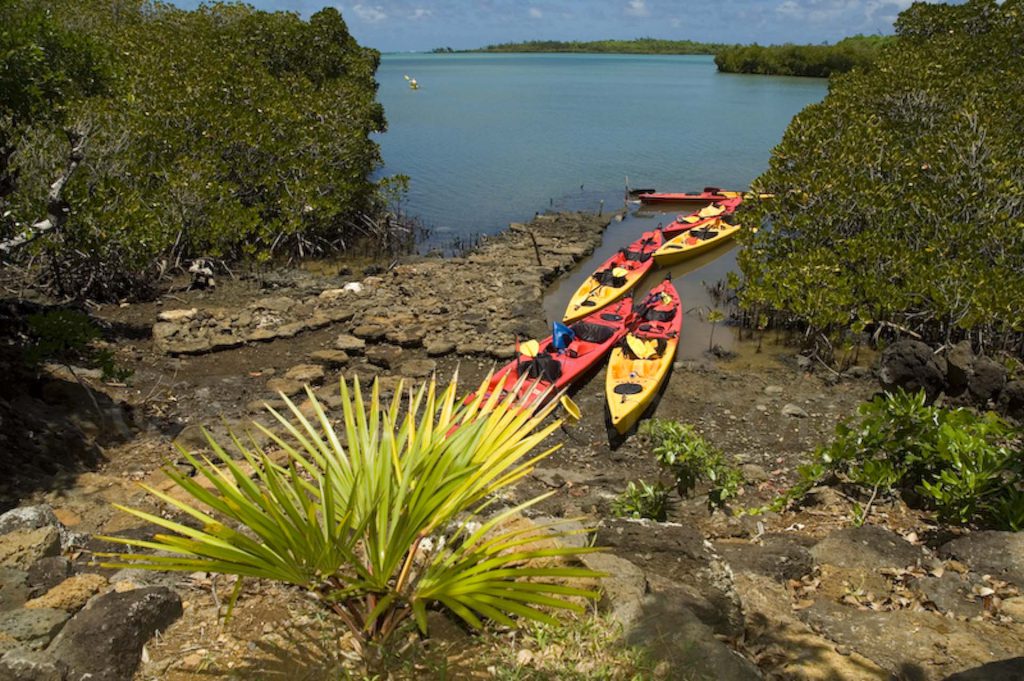The mangrove: a world worth discovering
After having crossed beautiful stretches of water dotted with islets in a 3,300 hectares maritime domain, you will gradually enter this very special universe through various navigation channels.
This natural area with a rich biodiversity spreads over 1,200 hectares at the far end of the bay of Fort de France. It is by far the largest in Martinique; the surface area of the other mangrove located on the Atlantic Coast is only 650 hectares.
Besides the fresh air, you will immediately be taken aback by the very special atmosphere of the place and will be able unrestrainedly enjoy the pleasures of paddling in this thick tunnel of vegetation.
You will also realise why the mangrove has always been considered as an excellent shelter during cyclones by the resident populations.
The important role of mangroves
As early as the beginning of the trip, an information stop will give everybody a breather while listening to the sound explanation provided on the need to preserve this special environment.
Although a certain number of people consider that this inhospitable place should be cleared up, it is worth reminding the usefulness of mangroves. They are the saviours of thousands of kilometres of coasts around the world. The tsunamis that hit these coasts would have an even more devastating effect without their presence. They trap significant amounts of carbon and filter the water from river basins, thus preventing silt from suffocating the corals in tropical coral zones like Martinique. They serve as a nursery for a multitude of fish species and their destruction would mean immediately reducing the fish population. They are a refuge for various birds as well; it is estimated that some 130 species visit the site, 37 of which are resident species. This area is of prime importance for migrant birds such as ducks, herons, terns and ibis, which travel along the Antilles Arc up to the USA.
The most sceptical ones only have to imagine what it would cost to build a water treatment plant as effective as these hundreds of hectares of mangroves!
Carried by the tide, you will be able to observe snowy egrets (Egretta thula), green herons (Butorides virescens) and ospreys (Pandion Haliaetus), among others, from a closer distance at vantage points known by your guide.
A discovery outing that provides first-hand knowledge on the environment
After having explained that the mangrove develops on the foreshore in water at more than 18 °C, your guide will provide you with more specific information on this very special ecosystem: the differences between red mangrove (Rhizophora mangle) and black mangrove (Avicennia germinans), what pneumatophores are or what plantlets allow reproduction and the spreading of the flora in this wetland area.
Your guide will also show you a mangrove flower and will explain how germination will produce a plantlet that will drop from the tree and due to its shape, sink into the muddy soil. The plantlet will take root very quickly and give birth to a new red mangrove tree.
He will remind you that this wood is hard to burn because it is soaked with salt water. It has been used by generations of fishermen to make pots and the abundant tannin of the red mangrove was used in the dyeing industry.
Stop at Petit Ilet on the way back
After emerging from the mangrove, you may roam around freely on the stretch of water lining the swamps. This large bay offers a stunning spectacle.
A stop for a more or less long period of time is scheduled on the way back. Those who have opted for a half-day trip will make a halt at Grand Ilet to enjoy a well-deserved ‘ti punch’ before being taken back by boat to their departure point. Those who have chosen a full-day outing will have leisure to have a barbecue on the spot and admire the charms of the place until the end of the day.
Outings on full-moon nights for bird watching are also offered by Kayak Nature Evasion.




